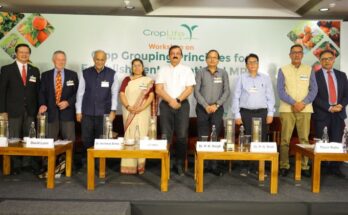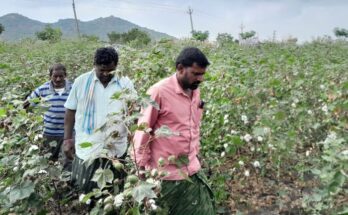“Sophisticated digital tools and technologies create miracles in agriculture by checking the quality, quick and better decision making based on AI (Artificial Intelligence) and ML (Machine Learning) predictions and forecasts, better trading platforms, better information, sustainable resource management, variability factors to increase yields and economics, says Rajesh Aggarwal, MD, Insecticides (India) Limited in an exclusive interview with Agriculture Post.
Excerpts:
What are the biggest challenges that are persisting in front of the agrochemical industry in India today?
The agrochemical industry is vital for crop protection and increasing the productivity in agriculture. Challenges are there for every industry, so this industry also has its set of challenges. Though agriculture sector is the most sought-after sector but crop protection is not. Encouragement to research and manufacture in India is one of the focal points that requires more attention. Long and lengthy registration process of the products is also one of the key challenges. Creating awareness and imparting the right information is again a key challenge for the industry which needs to be jointly addressed by the industry, academia and the government.
After the government’s SoPs on drone application in agriculture, how is this going to bring a paradigm shift in farming practices and how is Insecticides India leveraging this opportunity?
India gradually is adapting to advanced technologies and sciences in order to make procedures effective and easy. Favouring the farming sector, the government has released an SOP (Standard Operating Procedure) to use drones for spraying pesticides. With the drone system, it becomes easy and effective without being directly exposed to insecticides and the efficacy is also said to be increased by uniform spray. The application of agrochemicals using drones is a great move towards precision in Indian agriculture. IIL has also started its trials with drone technology and is already in talks with some of the leading drone-tech companies. Still, it is in the initial phase and true commercialisation of the same is awaited.
Modern digital technologies are bringing advancement in the farming sector. How do you foresee their impact in the next five years?
Increase in world population and the fact that India ranks second constantly creates an increase in demand for food supply in the country. In the past 50 years, the agriculture industry has tremendously evolved with technology participating and advances creating a huge impact to meet the demand. According to research, about one-quarter of fertile land is degraded and requires restoration before undergoing another round of cultivation. Modern technology is supporting agriculture with sustainable measures that help beat the increasing environmental pressures. In the next five to 10 years there is a high chance that technology will completely overtake traditional agricultural practices and help sustain the sector with better outcomes. Sophisticated digital tools and technologies create miracles in agriculture by checking the quality, quick and better decision-making based on AI (Artificial Intelligence) and ML (Machine Learning) predictions and forecasts, better trading platforms, better information, sustainable resource management, and variability factors to increase yields and economics. In terms of animal husbandry also, cutting-edge technologies will enhance the well-being of the stock is more available and apt to the concerns about animal welfare.
With technological advancements, thousands of startups have come up in the agriculture sector. So how does your industry embrace this ecosystem?
True! Today, agro companies and agritech startups are providing ground-breaking solutions to a number of challenges faced all across the agricultural value chain. Along with access to high-quality plant nutrition and agrochemicals, farmers now have access to advanced technology to forecast pest and disease infestations, use IoT (Internet of Things) devices for local weather updates, accurate and closer market prices forecast and more. It’s good to see the new wave of budding entrepreneurs and emerging startups in the country leading the way in disrupting the age-old agriculture system with innovative ideas and affordable solutions. We, at Insecticides (India) Limited, believe in community and collective growth.
Counterfeit crop protection products are a big menace to the agriculture sector. What mechanism should be in place to counter this and what steps is Insecticides India taking in this direction?
Yes, counterfeit crop protection products are a growing problem for the agriculture industry. These products pose a danger as their contents are unknown, untested and unregulated, which poses a serious threat to crops and the environment. Farmers often unknowingly purchase counterfeits only to realise their mistake at the much greater cost of damaging or losing their crops. In addition to economic challenges for the farmers, counterfeits can be harmful to the environment as they are not tested for efficacy or impact on human health and the environment, unlike legitimate crop protection products, which undergo rigorous testing under global and local regulations, before being offered in the market.
We, at Insecticides (India), professionally train farmers and other individuals on what, when and how to use crop protection products. Part of the training includes guidance on identifying spurious products and making sure that all products are purchased with proper bills and from an authorised dealer with a valid license. We are also in the process to adopt the technology tools like QR Code so that farmers can check and verify the genuineness of the products on the spot.
India is producing and exporting water-intensive crops like rice and sugarcane. What measures should India take for the sustainable utilisation of natural resources?
Several negative impacts on the environment are leading to scarcity of water and as a result a huge deployment of water-intensive crops like paddy and sugarcane. Conservation and sustainable management of water resources can help tackle this obstacle. Research is underway for the introduction of the low-water consumption varieties of paddy so that its area under cultivation also increases. Promoting micro-irrigation practices like “more crop per drop” will efficiently help in saving water in the irrigation process. The practice has already been implemented in a few states. Sustainable water management techniques can also contribute to this matter. Under many circumstances, the drip irrigation method, or micro irrigation can help in restoring the natural ecosystem by saving water to a larger extent in sugarcane. This is a win-win situation for the environment and for the water-intensive crops. Watershed management systems, the use of solar pumps, and investments in research and innovation are other methods to contribute to the purpose.
How do you see the impact of climate change on the agriculture sector in the near future and what measures would you suggest to combat it?
Agriculture is one of the most vulnerable sectors to the anticipated climate change. GHG (greenhouse gas) emission is increasing and soil, water bodies, and air are being polluted. The unprecedented rise in temperature has resulted in increased events of droughts, floods, irregular patterns of precipitation, heat waves and other extreme happenings throughout the globe.
Crop rotations, soil management, cover crops and reintegrating livestock into crop production systems can help from the impact of climate change to an extent. The regeneration process helps convert the carbon dioxide created by other industries into plant material or organic soil matter. Such methods also help improve soil quality and increase the ability to produce food on the land. To meet up with increasing food demand and increase yield per hectare, farmers must be encouraged to use biologicals and agrochemicals simultaneously as per the requirement.
How does Insecticides (India) focus on sustainable agricultural growth?
Approaching integrated crop management strategies, which include efficient biological and chemical solutions for healthy soil, disease, pest and weed-free crop cultivation and high-yield crop production, is the need of the hour. There is also a need to increase agrochemical R&D investment in the chemical and biologicals segment which will not only strengthen the crop protection and nutrition sector in India but also provide a way to move forward towards sustainable agriculture.
IIL currently has four research and development centres with different themes. The first one is NABL certified facility, which focuses on backward integration and formulation development. This centre has been instrumental in bringing in noticeable Make in India products by IIL. Second is a new product innovation R&D centre in JV with a Japanese company OAT Agrio. The third one is again focusing on new formulation development and process optimisation. The one in Shamli, Uttar Pradesh, is dedicated to the development of biological products for sustainable agriculture.
IIL has commercialised eight products as a result of the continuous efforts of researchers and scientists of this biological centre, including Mycoraja (Mycorrhizal biofertiliser), Milstim (liquid organic manure-based biostimulants), Prime Gold (micronutrient and gibberellic acid-based biostimulant), Root Bead (Mycorrhizal biofertiliser with Japanese surfactant for seed priming of leguminous crop seed), Milstim Max (carrier-based NPK consortia biofertiliser), Surya zinc+ (chemical zinc substitute Zn biofertiliser) and KKPro (bio enriched organic manure).
What marketing and branding activities are Insecticides India running to reach the maximum number of targeted farmers?
Both retaining existing customers and attracting a new set of prospective customers are important for business sustainability. To attract new-age customers, having a virtual presence and digital marketing capabilities are indispensable. So, we take advantage of digital marketing to explore virtual avenues of growth and profitability. In addition to our digital marketing initiatives for mass visibility, we continue to focus on demand-generation activities through rigorous in-person contact, result demonstrations and farmer meetings and field days. We organise retailer training, crop seminars, and meetings with farmers for raising awareness of our products and services. During every training programme and awareness seminar, safe and judicious use of crop protection products forms a vital part. To take the message of the safe and judicious use of agrochemicals to a larger audience, Insecticides (India) has also roped in the famous Bollywood celebrity Ajay Devgan.
What new offerings are we going to see from Insecticides (India) in the near future?
Insecticides (India) has been working since its inception with an objective to provide the best quality products within the reach of Indian farmers. We strive hard to keep adding the latest technology products every year through our R&D centres and our international partners.
This year we have launched Shinwa, a patented insecticide and Izuki, a new-age combination fungicide in technical collaboration with Nissan Chemical Corporation, Japan.
Torry and Stunner are the two products launched this year by IIL which were made in India for the first time and have received a remarkable response. We look forward to launch 2-3 more products this year.




